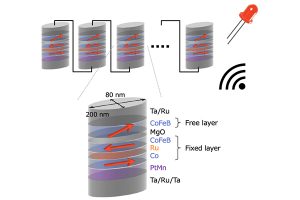Spintronic devices harvest Wi-Fi energy

The devices in question are non-vortex uniformly-magnetised spin-torque oscillators (see diagram)
Magnetic sensors have already been constructed from magnetic tunnelling junctions (MTJs) and, because of their non-linear electrical characteristics, certain MTJs should be able to act as high frequency oscillators and rectifiers.
The main part of the Singapore-Tohoku project was physically demonstrating something that earlier theoretical studies has suggested: that the frequency response of MTJs could sharpened if several were coupled through electrical connections
“The commercial viability of high-frequency MTJs is hindered due to a typically nanowatt output power and broad [MHz] linewidth,” according to Tohoku University. “Mutual synchronisation of multiple MTJs is one way to overcome this problem. However, an effective pathway to synchronise the MTJs at the Wi-Fi bandwidth has not been clear until now.”
80 x 200nm ‘canted anisotropy’ MTJs were designed, fabricated at Tohoku, and did indeed self-oscillate if four of them were connected in series or parallel with some dc bias.
Starting as unsynchronised oscillators, they became more harmonious as current increased, and were fully synchronised by a few milliamps.
Their ferromagnetic resonance was between 2.0 and 2.3GHz without an external magnetic field, and could be adjusted through 2.4GHz by applying a magnetic field.
The parallel combination produced a particularly clean output at 2.4GHz: with 8.4MHz bandwidth at 850nW.
One of the non-linear effects that can spin-torque oscillators can exhibit is the ‘spin-diode effect’, which results in a dc bias appearing across an rf-pumped spin-torque oscillator.
In a subsequent proof-of-concept, the Singapore-Tohoku team connected eight of their MTJs in series across a capacitor and irradiated them at 2.4GHz.
Around 30mV was generated, even without magnetic bias, at sufficient dc current to drive a red LED via an LTC3108 dc-dc converter – a chip designed for low-voltage energy harvesting.
“This has proven the potential of an on-chip array of the MTJs towards high-frequency applications such as wireless transmission and energy harvesting,” said project head Professor Hyunsoo Yang of NUS.
The work is covered in detail in the clearly-written Nature Communications paper ‘Electrically connected spin-torque oscillators for 2.4 GHz WiFi band transmission and energy harvesting‘, which can be read in full without payment.